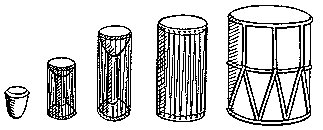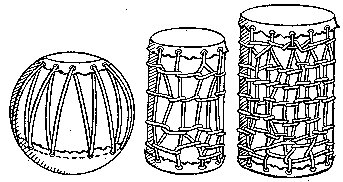|
TRANSLATIONS
Sounds communicate. I remember rowan, the whispering tree (and Thor's helper), and those four whispering spirits, 'Pure Henguingui', 'Pure Ki', 'Pure O' and 'Pure Vanangananga'. "The conversation reverted to the subject of speech. Its function was organization, and therefore it was good; nevertheless from the start it let loose disorder. This was because the jackal, the deluded and deceitful son of God, desired to possess speach, and laid hands on the fibres in which language was embodied, that is to say, on his mother's skirt. His mother, the earth, resisted this incestuous action. She buried herself in her own womb, that is to say, in the anthill, disguised as an ant. But the jackal followed her. There was, it should be explained, no other woman in the world whom he could desire. The hole which the earth made in the anthill was never deep enough, and in the end she had to admit defeat. This prefigured the even-handed struggles between men and women, which, however, always end in the victory of the male. The incestous act was of great importance. In the first place it endowed the jackal with the gift of speech so that ever afterwards he was able to reveal to diviners the designs of God." (OgotemmÍli) The eight families of the Dogon spoke different languages and they had different drums:
"Each drum had a sound of its own, and so each family had its own language, which is the reason why there are different languages today. The first two families, settled in the south, spoke two dialects of Toro, not very different from each other; the third family spoke Mendťli; the fourth spoke Sanga; the fifth another form of Toro; the sixth Bamba; and the seventh Irťli. Lastly the eighth family was given a language which is understood in all parts of the cliff. Just as the eighth drum dominates all the others, so the eighth language is understood everywhere. It was thus that men were given the third Word, final, complete and multiform to suit the new age. It was closely associated, like the first and second Words, and even more than they, with material objects. At this point an odd reflection occured to the European. The first imperfect Word was associated with a technical process, simple in character and no doubt the most archaic of all processes, which had produced the most primitive form of clothing made of fibre. The fibre, which was neither knotted nor woven, flowed in a wavy line, and might be said therefore to be of one dimension. The second Word, less restricted than the first, arose from weaving, done on a wide warp crossed by vertical threads forming a surface, that is to say, having two dimensions. The third Word, clear and perfect in character, took shape in a cylinder with a strip of copper winding through it, that is to say, in a three-dimensional figure. These three technical processes (as he further remarked) all proceeded by following a line, either undulating or zig-zag, and each was characterized by three distinct features: humidity of the fibres, ensuring the freshness necessary for procreation; light for the weaving, that being a daylight process, prohibited at night on pain of blindness; sonority of the drum. There was also a development, from the material point of view, from trimmed bark to cotton thread, and from thread to leather strips and to a copper band." (OgotemmÍli) In Tahua we find the zig-zag kava band (GD34) just in one glyph, Aa8-31:
I have listed one more glyph as GD34, Aa2-75, but there the sign seems to be deformed:
If - as I have suggested - GD34 signals the death-and-rebirth of the king (together with lightning hitting the earth and thunder rolling), then the last line of side a seems an approriate location. The surrounding glyphs do not contradict this idea:
At Aa8-26 (notice 26) we find viri, the 'clew' or 'corner of the sail', in Aa8-28--29 we see an arrangement reminding us about the back-to-back lions of Egypt, marking transfer of rulership to the next period (7 + 7 = 14 marks) and in Aa8-30 the sun may be in hua phase. In Aa8-31 we at right find a 6-marked figure, somewhat similar to Aa1-41 and parallel glyphs (arriving just before midnight):
Is this shape a child not yet born? The jackal Y is the son of God, i.e. (reasonably) the 2nd half of the year (counting from winter solstice). The 1st half of the year is male and symbolized by a straight staff, the 2nd half is symbolized by a forked staff (reminding us about mother earth). During the night Y is ruling: "... 'Clothed in the skirt', said OgotemmÍli, 'the jackal went on to the roof of his father's house, believing him to be dead.' The father of the jackal was God; and, God being temporarily asleep, his son, who was also his rival, thought he was dead. Prefiguring one of the essential actions of the funerary rites which men were later to institute, the animal went up on to his father's terrace to mourn for him. Dressed as he was in the fibres taken from his mother, the jackal danced and as he danced, he spoke, for the fibres were full of moisture and words. They had in them the first Word revealed by the Nummo to the earth, and it was this water and this Word which made the animal speak. God's son spoke his dance. His steps left traces in the dust of the terrace which indicated the meaning of his Word. 'In his dance', said OgotemmÍli, 'he left three tracks lengthwise and three crosswise, representing God's Roof, the inside of his house, and the recess where the altar of the dead is placed. He planted little pieces of wood, placed stones and traced signs.' 'The son of God in celebrating the memory of his father, whom he believed to be dead, acted, spoke, and traced out the world and its future. He spoke the first Word, and he laid bare the future of the world. In his anger he revealed the secrets of God.' 'For he honoured his father and flouted him. He had taken his mother's fibres, which were full of the Word that contained the designs of the celestial powers.' The terrace where the jackal danced was the first divining table. Later men copied it in the sand round about the villages. The reference was to the rectangles of smoothed sand, on which diviners write their questions, and the jackals lured by bait come by night and write the answers." (OgotemmÍli) The terrace of God seems to be winter solstice. The triplet Aa1-13--15 may reflect the Dogon ideas, with God temporarily 'dead' visualized in Aa1-13:
The Y-form in GD47 (tŰa) appears on side a of Tahua only during e.m. and during the night:
On side b I have registered 5 glyphs:
Maybe, therefore, the Y-form in Tahua is reserved for the true night (not for the dark half of the year or the dark phase of the month)? In the week (according to H) the temporarily 'dead' sun god maybe is illustrated by Hb9-19:
Jumping from Tahua to another tablet text might be risky, but I anyhow must document the similarity between the Friday Hb9-50 and Aa8-28--29 - both have twice 7 marks:
Furthermore, there are fishes not only in Saturday (Hb9-53) and in Aa8-24--25 (immediately before Aa8-26 etc - see above):
There are structural similarities between the week and the year. |





















